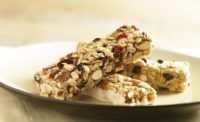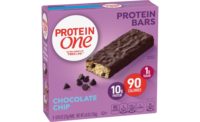The snack and granola bars category continues to perform well, with IRI, Chicago, reporting that sales hit $5.6 billion for the 52 weeks ending March 22, 2015, up 3.47 percent in dollar sales—and that figure saw a nice boost from the nutritional and intrinsic value bars segment, which saw dollar sales growth of 9.41 percent for the period.
View an extended image gallery
In its February 2015 report, “Functional Foods: Key Trends by Product Categories and Benefits,” Packaged Facts notes that nutrition bars are helping pave the path to a new breed of sports-nutrition products as more shoppers opt for “more natural formulations” and lean away from sugary sports drinks.
Foodservice is also a viable market for bar sales. In February 2014, the NPD Group reported that its SupplyTrack data showed foodservice snack bar sales up 15 percent in dollar sales, particularly in lodging establishments.
Bar backstories
It should come as no surprise that these nutritional products often come with health halos like natural, organic, non-GMO and gluten-free—all aspects frequently connected to the concept of “clean label” these days, which is open to various interpretations.
“‘Clean label’ means only whole-food ingredients,” says Corey Rennell, CEO, CORE Foods, Oakland, CA. “No syrup, salt, flour, oil, additives, preservatives or flavoring agents.”
When Rennell set out to create his Core Meal bars, he went with the basics. “We focused on simple,” he says. “How can we get the building blocks of a healthy meal with the fewest possible ingredients? Oats, nuts and fruit. Done.” To bring flavor into the mix without impacting the ingredient statement, he uses spices.
“People are tired of sugar,” says Rennell. “Bars full of syrup and oil are behind the times.”
The interest in clean label is a natural fit for fruit ingredients, says Mark Crowell, principal culinologist, CuliNex LLC, Seattle. “Consumers are looking for claims like ‘made with real fruit,’ ‘sweetened with fruit juice’ and ‘contains no high-fructose corn syrup.’ Fiber is also in high demand, and fruit purées, pastes and powders are a natural, cost-effective way to deliver against this claim.”
The growing demand for healthier options has had strong impact on product development in the last few years, says Marilyn Stieve, business development manager, bars, Glanbia Nutritionals, Fitchburg, WI. “Today’s health-conscious consumers pay careful attention to factors such as nutritional call-outs, ingredient lists and calories, which, in turn, leads manufacturers to seek increased labelling transparency, healthier reformulation and clean-label status.”
Clean-label solutions can stem from fruit ingredients. “Fruit juice or purée can be used to naturally adjust pH levels and aid in clean-labeling,” says Jeannie Swedberg, director of business development, Tree Top Inc., Selah, WA. “Fruit powder is used to bind water, eliminating the need for gums or other water-activity stabilizers that may not be recognizable by the consumer.”
Flavor profiles
Fruit is a staple in bars. Swedberg notes that her company continues to see a tremendous amount of interest from product developers to add fruit to their new product formulas. “The majority of sample requests we receive are for the more-traditional fruits.” These include cranberry, raisin, date, apple, blueberry, strawberry, raspberry and cherry.
Others see more-niche interest—for now. “Recently, more premium and tropical fruits like mango, coconut and pineapple have become popular,” says Emily Munday, nutritionist, CuliNex. “Cost-effective fruits such as dates and prune purée can be used as ‘base fruits’ to which the popular characterizing fruits above can be added. Prunes, for instance, synergize particularly well with dark fruits like blackberry, cherry, blueberry and mixed berry.”
Some superfruits also work their way into the mix. “We have seen some interest in elderberry, goji, bilberry, baobab and mango,” says Swedberg.
“Americans are in love with the idea of ‘superfoods,’ and while most fruits are nutrient-dense, the trendy, exotic fruits such as goji berry, acerola and pomegranate are often touted for their increased macronutrient content,” says Munday.
Swedberg illustrates the many benefits of fruit: “Fruit purée and fruit pieces are typically used for color, texture and visual piece identification. A combination of fruit ingredients, including powders, juices, purées and pieces, is used to promote the natural and wholesome image inherent in fruit.”
And fruit often goes hand-in-hand with nuts in bars. “Almonds in their whole natural form lend a definitive snap and crunch to a bar’s texture,” says John Csukor, CEO/CMO, KOR Food Innovation, Richmond, VA. “They also add a visually appealing, premium image, which is identifiable as a standard of high quality.” He recommends using almond butter as a clean-label-friendly binder that also brings a nutty creaminess to other flavors. Diced almonds can add a distinct crunch, while sliced almonds lend more of a chewy texture.
Peanuts also find a regular home in bars, and the wide range of peanut ingredients can bring diverse eating experiences to bars. Roasted, defatted peanut flour brings protein to the mix, is gluten-free and helps build an appealing flavor profile.
To build spotlight the better-for-you nature of bars, Munday suggests paring seeds and even vegetables with fruit, such as strawberry, spinach and beet; kale, mango and pineapple; cranberry, lemon and chia; and raspberry, almond and flax. “Even savory flavor elements like barbecue and smoke are making their way into fruit-based bars.”
Could savory be the new black in the bars category? The U.S. bar market has begun to see more new savory flavor profiles, including flavors and ingredients like roasted jalapeño, smoke, mustard and barbecue, and not just in Paleo-centric bars focused on meat.
Targeted nutrition
“Fruit ingredients are a nutritional powerhouse,” says Crowell. “The gap between ‘supplement’ and ‘food’ is closing, as consumers want more benefits from their meals, especially at snack time. Focus on specific health benefits to increase the value of products, such as fiber, satiety, antioxidants, sustained energy and gastrointestinal health.”
Bar manufacturers have a well-stocked toolbox of ingredients these days to align with prevailing shopper trends. “Popular trends in the nutritional bars segment include protein fortification, ancient grains and seeds—mainly chia and flax—low-sugar formulation, fiber enhancement and positioning around energy and satiety,” says Stieve. “Gluten-free has had a huge impact on the snacking sector. Ancient grains, like chia and quinoa, are becoming extremely popular within the bar segment because of their natural profile, protein, and fiber content.” She notes that her company’s new Ancient Grain Protein Crisps combine the benefits of protein and ancient grains such as quinoa, amaranth, sorghum, chia or flax.
But like all other product categories going gluten-free, functionality remains a key to gluten-free bars’ long-term success. “Functional ingredients that improve texture and enhance nutrition, such as ingredients with strong water-binding properties that also allow sugar reduction, are crucial in gluten-free bar applications,” says Stieve.
“Extremely popular among consumers at all levels, protein fortification is evolving with a number of new launches that range from vegan-friendly plant protein fortification to innovative combinations of proteins from different sources, to combine complementary amino acids,” says Stieve.
But take note: Manufacturers considering nutrient-content claims on product packaging need to carefully review Title 21 of the FDA Code of Federal Regulations, Part 101, which covers food labeling, to ensure all criteria for claims are met.
While bars remain emblematic of snacking on-the-go, they can grow even more convenient through resealable packaging and bite-sized portions. “In terms of applications, as bars gain popularity in mainstream markets, versatility and convenience remain key factors to attract consumer attention,” says Stevie. “The demand for healthier, on-the-go products that suit the busy lifestyle of today’s consumers is set to grow in the next few years, with the expansion of bite-size portions and products targeted to specific audience, such as kids, baby boomers or Millennials.”
Adding new dynamics to the bar eating experience can also pay off. “We are seeing increased interest in layered bars, a crisp layer followed by a chewy layer of fruit,” says Swedberg.
Even alternative proteins are beginning to see some benchtop experimentation. A new concept from Wixon Inc., St. Francis, WI, boldly highlights cricket flour in a bar formulation that also includes oats, chia, pumpkin seeds and dried cherries.
The fantastic diversity at play in bars today will invariably lead to strong innovation as manufacturers and supply-chain partners explore any and all ideas—bar none.






